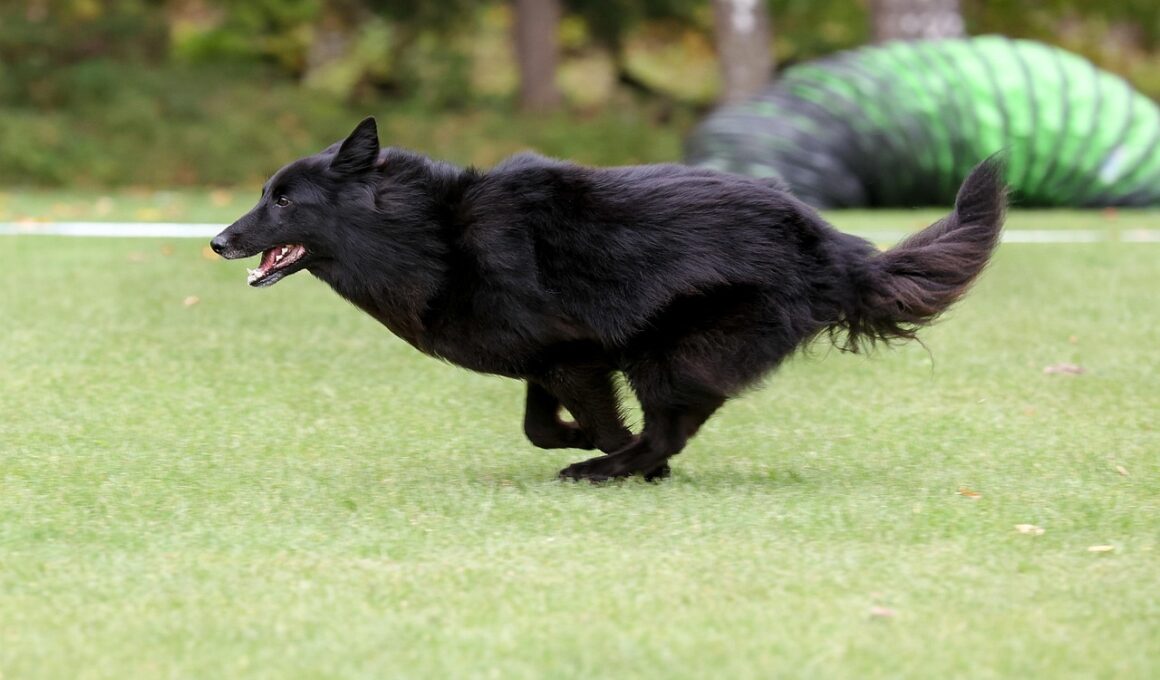Setting Realistic Goals for Your Dog’s Agility Progress
Agility training is a fun and dynamic way to engage your dog in a sport that requires both physical and mental stimulation. Setting realistic goals is essential in ensuring that your dog progresses effectively through their training journey. Start by understanding your dog’s current skills and fitness level. Observe how quickly they learn new commands or navigate obstacles. For instance, if your dog struggles with basic commands, it may be best to focus on improving these before tackling agility courses. This foundational step will make the transition smoother as they progress. Additionally, factor in your dog’s breed and natural agility. Some breeds are predisposed to excel in agility, while others may require more time. By tailoring your goals to their abilities, you can create a structured, supportive training environment that encourages learning. Celebrate every small achievement and ensure that your dog enjoys the process. Connecting with other agility enthusiasts can also provide valuable insights and motivation. Ultimately, the bond you create through training will enrich both your lives and facilitate progression.
When setting goals for agility training, the SMART criteria is an excellent approach to adopt. This framework focuses on creating Specific, Measurable, Achievable, Relevant, and Time-bound goals. For example, rather than stating that you want your dog to be better at agility, specify that you want them to complete a jump course successfully within three months. Break down the process into smaller, manageable tasks. Begin with basic jumps and work your way up to more advanced skills as they improve. Consistency is key in reinforcing your dog’s training. Implement training sessions that occur regularly and last around five to 10 minutes. Keeping training short ensures that your dog remains engaged and eager to learn. It’s also important to monitor their progress regularly. Keeping a training journal can help you visualize achievements and identify areas that may need more focus. This documentation can enhance your understanding of your dog’s learning curve while keeping motivation high. Remember, every dog learns at their own pace, and patience is crucial during this journey.
Positive Reinforcement Techniques
Utilizing positive reinforcement techniques during agility training can significantly help in achieving your goals. Dogs are motivated by rewards, whether it be treats, toys, or praise. Establishing a reward system that suits your dog’s preferences will encourage them to engage enthusiastically with training tasks. For instance, if your dog performs a successful jump, you might immediately offer a treat or verbal praise as a reward. Be attentive to your dog’s responses to different types of reinforcement. This observation will help you adjust your methods to fit their unique personality. Positive reinforcement fosters a sense of accomplishment, which strengthens the bond between you and your dog. Over time, as your dog becomes more confident in their abilities, you can gradually decrease the frequency of treats while still providing verbal praise. Moreover, incorporating playtime after training reinforces a positive association with the agility exercises. Remember, agility training should always be enjoyable for both you and your dog to maintain motivation and enthusiasm throughout the process.
Incorporating variety into your dog’s agility training routine can prevent boredom and enhance motivation. Dogs thrive on new experiences, so shifting the training setting or introducing new equipment can make sessions exciting. For example, if your dog has mastered jumps at the park, consider moving to a different location or using different sizes and types of jumps to keep things fresh. Continuously changing obstacles will encourage your dog to think critically and adapt to various challenges. Additionally, mixing in different training activities, such as obedience exercises or socialization opportunities with other dogs, can contribute to your dog’s overall agility skills. This comprehensive approach helps create a well-rounded training experience. Engage in friendly competitions or fun agility events with your dog to further foster a love for the sport. These activities encourage not only skill improvement but also enhance the bond you share with your dog. Always end training sessions on a positive note to ensure that your dog associates agility training with fun and achievement, which ultimately leads to reaching your set goals.
Adapting Goals Based on Progress
Regularly reviewing and adapting your agility training goals based on your dog’s progress is crucial for continued improvement. While setting initial goals provides direction, flexibility ensures that the training remains effective and relevant to your dog’s evolving skills. If you notice that your dog is mastering jump sequences faster than anticipated, consider challenging them by introducing complicated obstacles or timing events. Conversely, if they struggle with specific tasks, it may be beneficial to revisit the fundamentals and slow down the pace. Celebrate small milestones to keep motivation high, as this reinforces positive behavior. Engaging with agility communities can also provide additional insights on goal-setting and training adaptation. Share your successes and challenges with fellow dog trainers who understand the unique journey. Additionally, regular consultations with a professional trainer can help provide guidance tailored to your dog’s specific needs. By adopting a growth mindset and being open to adjusting your goals, you’ll be paving the way for enhanced skills and quality time spent together in the agility arena.
The significance of patience in agility training cannot be understated. Training a dog for agility is a journey that requires time and commitment. While it can be tempting to rush the process in hopes of achieving quick results, taking the time to ensure your dog fully comprehends each skill is far more beneficial in the long run. Progress may sometimes be slow, and setbacks are normal. Celebrating small victories becomes essential to maintain motivation, and perseverance through challenging periods is necessary. Understand that consistent practice will lead to improvement over time, allowing your dog to build their confidence and skills gradually. Using techniques such as breaking skills into smaller components can help make the process digestible for your dog. For instance, teach them how to weave through poles one at a time before combining them into a full sequence. Incorporating rest days is also crucial as they allow your dog to recover, which ultimately enhances performance. As time progresses, adjust your goals along the way instead of feeling overwhelmed by the bigger picture. Keep focused on the journey, and enjoy watching your dog flourish.
Conclusion
In conclusion, setting realistic goals for your dog’s agility training is essential for both you and your furry friend. Using the SMART criteria, positive reinforcement techniques, and variety in training can significantly enhance your dog’s overall performance. Regular review and adaptation of your goals based on your dog’s progress will help you stay aligned with their learning journey. Moreover, patience remains a vital component when training; recognizing that every dog evolves at their own pace will foster a successful training environment. Building a supportive network and sharing experiences with other agility enthusiasts can also provide useful insights and inspiration. Remember that creating joyful and rewarding experiences during training strengthens the bond you share with your dog, making the entire process worthwhile. Ultimately, by focusing on these fundamental aspects and keeping it enjoyable, you pave the way for a happier, more agile companion. Embrace the process, celebrate achievements, and enjoy every moment spent with your agile partner.
As you commence this vibrant journey of agility training, remember that your efforts will forge a path to success that both you and your dog can appreciate. Be active in learning, staying engaged with your dog and observing their preferences, behavior, and reactions during training sessions. Your commitment will cultivate a meaningful partnership that enhances not only agility skills but overall well-being. This supportive environment will encourage your dog to thrive, fostering both physical and emotional growth with each completed goal. The experience of agility training is not solely about competition; it can also be an extraordinary way to deepen the connection you both share. So, gear up, embrace the adventure and set the course for a fulfilling agility experience that brings joy and excitement to your canine companion.


